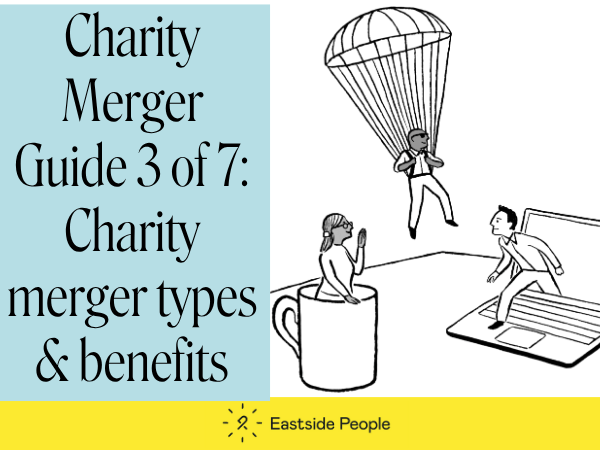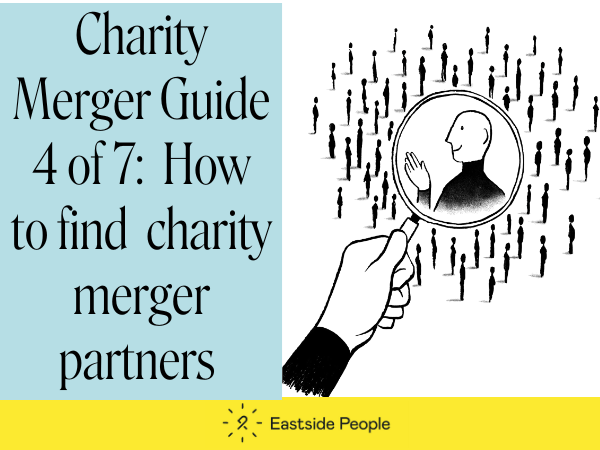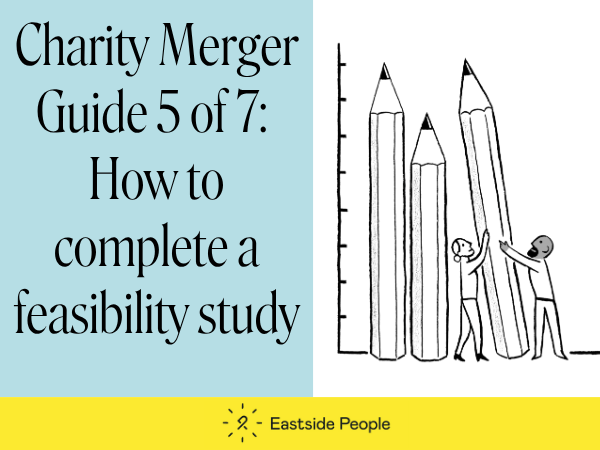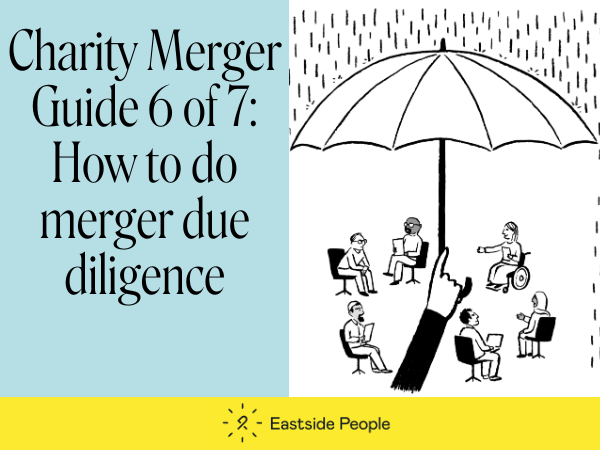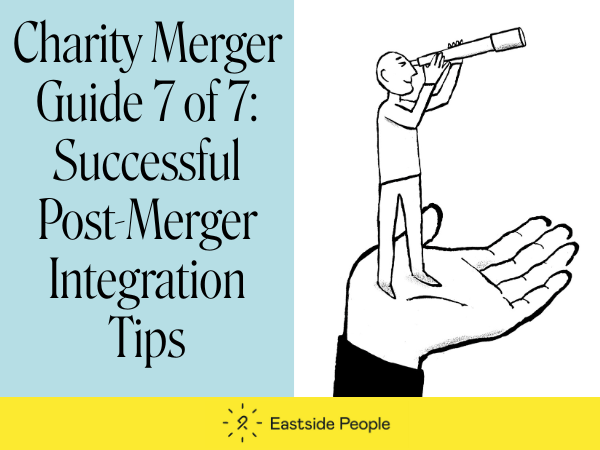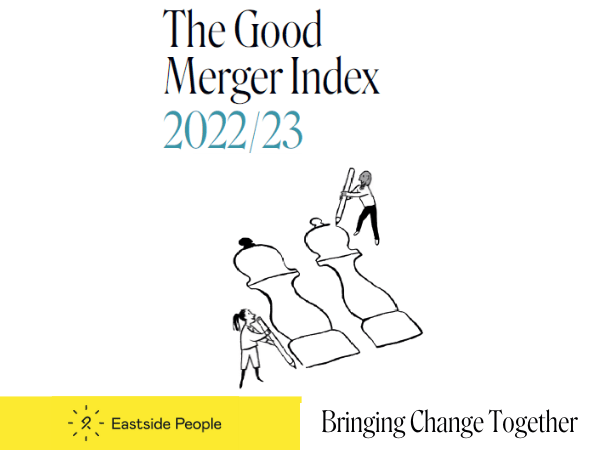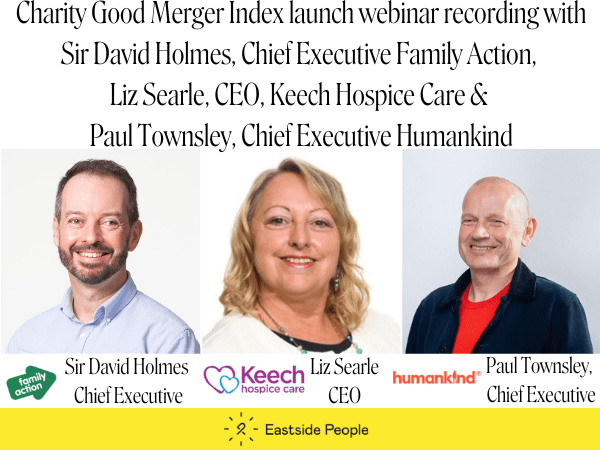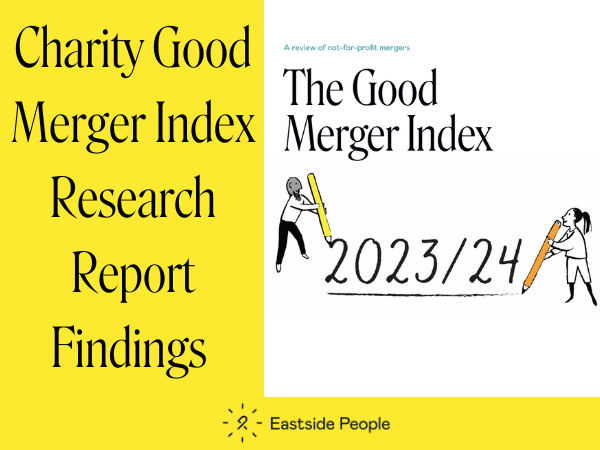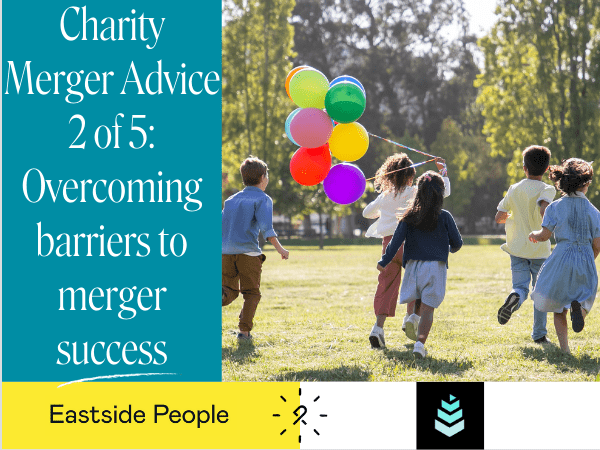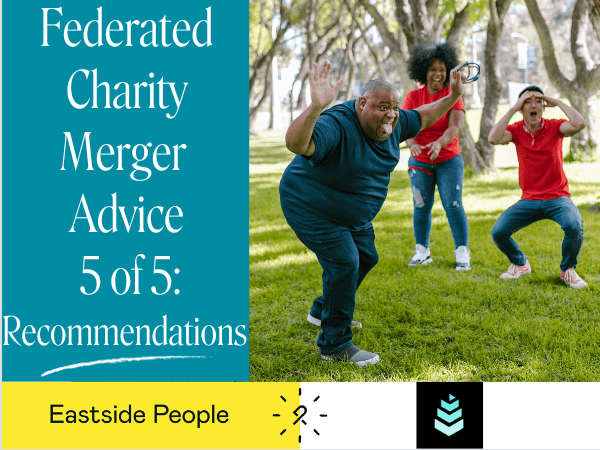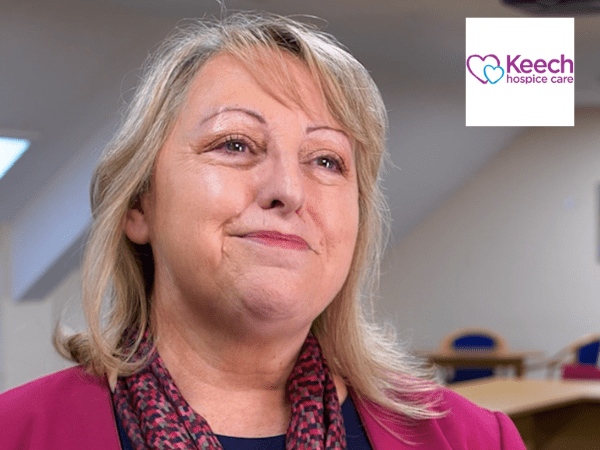Successful mergers can have a transformative effect changing the scale, reach and prospects of an organisation and creating a better deal for the people that rely on a charity’s services. At Eastside People, we have been supporting charities and other not-for-profit organisations through partnerships and mergers for over a decade. In that time, we have witnessed organisations embark on partnerships and mergers for a myriad of reasons.
The Good Merger Guide was created by Eastside People to:
- Highlight the main questions to consider before embarking on a merger
- Provide step by step advice on the three stages of managing a merger.
We have taken some of the best advice and guidance from the Good Merger Guide focusing particularly on the practical and technical aspects of mergers. The 7 articles that make up the set are a must read for anyone in a charitable organisation considering merger as a possible option and wanting to know more about what is involved. This is article 2 of 7.
The 7 main challenges to charity merger … and how to overcome them
Like every organisation, every merger is unique, bringing its own benefits and challenges. For charities that have never undertaken a merger, we know that the process can seem mysterious, confusing and risky. Many are understandably concerned about what the merger process entails.
At Eastside People, we have supported 46 organisations through the merger process. In this article, we summarise the 7 main challenges that we have encountered, together with some approaches to successfully address these, so that wherever your starting point you will feel better equipped to navigate the challenges of charity merger.
- Cultural Differences
Merging organisations may have different cultures, values, and ways of working. Even where organisations appear closely aligned in these respects, it is likely that there will be some differences. These have the potential to create conflicts and challenges in the post-merger integration stage.
- Loss of Identity
Charities may fear losing their unique identity, history, and brand through a merger. Beyond a general threat to their sense of identity, loss of identity can also have wider, practical implications. It may make it difficult to maintain funder relationships and stakeholder support.
- Financial Risks
The merger process itself can generate additional costs, for example, the costs of integration, restructuring and/or rebranding. In additional, while most mergers do ultimately bring some savings, these rarely come straight away. Anticipated cost savings may take a long time to come about, or indeed never materialise at all.
- Staff Concerns
While charities will not want to lose key staff during the merger process, employees are likely to feel some uncertainty, anxiety, and possibly job insecurity. Concerns about job losses or changes in roles can have detrimental impact on morale and create resistance to change, and to the merger process itself.
- Legal and Regulatory Hurdles
Unavoidably, merging charities will have to navigate some complex legal and regulatory requirements, including compliance with employment and charity law. It is not always straightforward to identify all such requirements at the outset, and working through these issues can take time and cause delays.
- Lack of Strong Leadership
Mergers are complex change projects. Poor leadership – and related to this, poor communication – will create major barriers to success. When it comes to communication, all internal and external stakeholders need to receive consistent, regular communications reinforcing the benefits of the merger. A lack of good leadership will make it unlikely that an organisation communicates effectively with its stakeholders, making it extremely difficult to successfully bring everyone along on the merger journey.
- Resistance to Change
You may encounter staff, trustees and other groups of stakeholders who are fearful of the unknown, and/or reluctant to accept the changes that a merger will bring. This is something to watch out for throughout the merger process as resistance can arise at any stage.
Strategies for Overcoming Challenges
It is essential that your prospective merger partner has compatible objectives, culture, and values. Please read Article 4: Seven steps to find charity merger partners for guidance on how to find a suitable merger .
Ensure there is a unified approach at the board level, with genuine collective consensus among trustees that merger is the best way forward. It is natural and fine for individual trustees to have different opinions, but strategic decisions should be collective.
Develop your ‘reasons to believe’ from the outset. Please read Article 1: Top Benefits & Reasons for Charity Mergers for information on how to develop your ‘reasons to believe’.
These are the principles that will underpin the merger process, and we recommend that you crystalise these as a positive vision of the merger, no matter the context. Even if you are entering the merger process from a position of financial difficulty, there is a positive way to frame your reasons for embarking on merger.
Your ‘reasons to believe’ will be an invaluable reminder of the strategic benefits you are seeking through merger – you will need this reminder as you experience bumps along the way.
Maintain open and transparent communication with stakeholders throughout the merger process. In our experience, the sooner the senior leadership team are involved and engaged in the process, the higher the chance that the merger will prove successful. Similarly, while it is up to you to decide when to inform the wider organisation, clear, considerate and transparent communications will set you up for success.
- Careful Analysis and Due Diligence
We strongly recommend that you develop a detailed business case or feasibility study, outlining the reasons, costs, risks, and benefits of merging at the outset of your journey.
The due diligence process should uncover essential information about your potential merger partner. This is a vital step in the process of assessing the risks and benefits of the merger. A thorough due diligence process will ensure you are able to make a well-informed decision about whether to go ahead with the merger.
Do what you can to identify potential deal breakers as early as possible. Often, these can emerge in relation to identity, location, service model, and leadership structure. Please read Article 5 of 7: How to complete a charity merger feasibility study for guidance on how to do an effective feasibility study.
Once you have identified these issues, don’t sit on them. Create the space to develop solutions to the key challenges.
- Consider a Staged Process
For more complex mergers, consider a staged process. Integrating the organisations in phases, rather than all at once, will allow you to address issues systematically and gradually, rather than all at once, while maintaining business as usual.
It is common to have an early conversation with a solicitor to identify any areas where you may need legal advice. In most cases, it will be prudent to involve legal, financial, and HR professionals for guidance, especially for larger or more complex mergers.
We know from our own direct discussions with funders, that some can and will help existing grantees with financial support to contribute to the costs of merger.
Careful planning, clear communication and a focus on shared goals will go a very long way to addressing the challenges that may arise during a merger process, significantly increasing the chances that the merger will strengthen your impact and sustainability.
Next Steps:
We feel that the sooner you start thinking about merger and partnership the greater the chance of success.
We are here to help you wherever you are in the merger journey. Contact us for a free, completely confidential 30-minute advice session with one of our merger experts to discuss how to take the next steps.
Find out more about our charity and not-for-profit merger and partnership consultancy services.
While the Good Merger Guide is available for download, as this was originally created in 2014 it contains older case studies and references. Please refer to the latest Good Merger Index and our website merger topics section for our latest case studies, blogs, insights and other merger-related content.
Read the other articles in our ‘how-to’ charity merger series.




